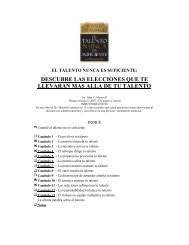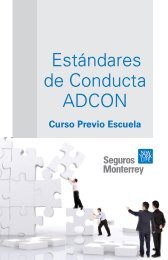SMARTPROS LTD. 2010 Annual Report to Shareholders
SMARTPROS LTD. 2010 Annual Report to Shareholders
SMARTPROS LTD. 2010 Annual Report to Shareholders
You also want an ePaper? Increase the reach of your titles
YUMPU automatically turns print PDFs into web optimized ePapers that Google loves.
smartpros ltd and subsidiaries<br />
Notes <strong>to</strong> Consolidated Financial Statements Years Ended December 31, <strong>2010</strong> and 2009<br />
Note 1.<br />
Description of Business and Summary<br />
of Significant Accounting Policies<br />
Nature of operations - SmartPros Ltd. and Subsidiaries (“SmartPros” or the<br />
“Company”), a Delaware corporation, was organized in 1981 as Center for Video<br />
Education Inc. for the purpose of producing educational videos primarily directed<br />
<strong>to</strong> the accounting profession. SmartPros’ primary products are periodic video and<br />
Internet subscription services directed <strong>to</strong> corporate accountants and financial<br />
managers, and accountants in public practice. In conjunction with the acquisitions of<br />
Loscalzo Associates, Ltd. (Loscalzo), and Executive Enterprises Institute (EEI), the<br />
Company is now a leading provider of live training <strong>to</strong> accounting, legal, and financial<br />
services professionals. In addition, the Company produces a series of continuing<br />
education courses directed <strong>to</strong> the engineering profession, a series of courses<br />
designed for candidates for the professional engineering exam, and training for<br />
information technology professionals. Its wholly owned subsidiary, SmartPros Legal<br />
and Ethics, Ltd. (SLE) produces ethics, governance, and compliance programs for<br />
corporate clients and, through its Cognistar division, produces online and cus<strong>to</strong>mized<br />
training courses for the legal profession. Through its wholly owned subsidiary, Skye<br />
Multimedia Ltd. (Skye), the Company produces cus<strong>to</strong>mized training solutions<br />
for a number of industries, including pharmaceuticals, professional services, and<br />
others. The Company has also acquired a library of nationally certified online<br />
training solutions for the banking, securities, and insurance industries, and courses<br />
designed for live training. SmartPros also produces cus<strong>to</strong>m videos and rents out its<br />
video production studio for a fee. SmartPros’ corporate headquarters is located in<br />
Hawthorne, New York, where it maintains its corporate offices, new media lab,<br />
and video production studio<br />
Basis of presentation - The consolidated financial statements of SmartPros<br />
include the accounts of SmartPros and its wholly owned subsidiaries, SLE, Skye,<br />
and Loscalzo. All significant intercompany balances and transactions have been<br />
eliminated.<br />
Estimates - The preparation of financial statements in conformity with generally<br />
accepted accounting principles requires management <strong>to</strong> make estimates and<br />
assumptions that affect the reported amounts of assets and liabilities and disclosure<br />
of contingent assets and liabilities at the dates of financial statements and the<br />
reported amounts of revenues and expenses during the reporting period. Actual<br />
results could differ from those estimates.<br />
Revenue recognition - The Company recognizes revenue from its subscription<br />
services as earned. Subscriptions are generally billed in advance on an annual<br />
basis, deferred at the time of billing and amortized in<strong>to</strong> revenue on a monthly basis<br />
over the term of the subscription, generally one year. Engineering products are<br />
non-subscription based and revenue is recognized upon shipment or, in the case<br />
of online sales, upon receipt of payment. Revenues from other non-subscription<br />
services, such as Website design, video production, consulting services, and cus<strong>to</strong>m<br />
projects, are recognized on a percentage of completion method where sufficient<br />
information relating <strong>to</strong> project status and other supporting documentation is<br />
available. The contracts may have different billing arrangements resulting in either<br />
unbilled or deferred revenue. The Company obtains either signed agreements or<br />
purchase orders from its non-subscription cus<strong>to</strong>mers outlining the terms and conditions<br />
of the products or services <strong>to</strong> be provided. Otherwise, revenues are recognized after<br />
completion and/or delivery of services <strong>to</strong> the cus<strong>to</strong>mer. Revenues from live training<br />
programs are recognized upon completion of the conference or seminar, which<br />
usually last one <strong>to</strong> three days. Expenses directly related <strong>to</strong> the seminars, including<br />
marketing costs, are charged <strong>to</strong> operations in the period in which the seminar is held.<br />
Segment reporting - The Company has evaluated the requirements under Topic<br />
280, Segment <strong>Report</strong>ing, of the Accounting Standards Codification (ASC). The<br />
Company’s management moni<strong>to</strong>rs the revenue streams of its various products and<br />
services; however, operations are managed and financial performance is evaluated<br />
on a Company-wide basis. Accordingly, all of the Company’s operations are considered<br />
<strong>to</strong> be aggregated in one reportable segment, educational services.<br />
Cash and cash equivalents - All highly liquid instruments with an original maturity<br />
of three months or less are considered cash equivalents. From time <strong>to</strong> time, the<br />
Company invests a portion of its excess cash in money market accounts that are<br />
stated at cost and approximate market value.<br />
Concentration of credit risk - Financial instruments that subject the Company <strong>to</strong><br />
concentrations of credit risk consist primarily of cash and cash equivalents, and<br />
accounts receivable. From time <strong>to</strong> time, the cash balances exceed the Federal Deposit<br />
Insurance Corporation (FDIC) coverage limit of $250,000. The Company’s cash<br />
balances are deposited with high credit quality financial institutions <strong>to</strong> mitigate this<br />
risk. No single cus<strong>to</strong>mer represents a significant concentration (over 10%) of sales or<br />
receivables. With the recent economic downturn in the banking sec<strong>to</strong>r, the Company<br />
closely moni<strong>to</strong>rs its cash investments in money market funds.<br />
Accounts receivable - Accounts receivable are recorded at net realizable value<br />
which is the original invoice amount less an allowance that management believes<br />
will be adequate <strong>to</strong> absorb estimated losses on existing accounts receivable. The<br />
allowance is established through a provision for bad debts charged <strong>to</strong> operations.<br />
Accounts receivable are charged against the allowance for doubtful accounts when<br />
management believes that collectibility is unlikely. The allowance is an amount that<br />
management believes will be adequate <strong>to</strong> absorb estimated losses on existing<br />
accounts receivable, based on an evaluation of the collectibility of accounts receivable<br />
and prior bad debt experience. This evaluation also takes in<strong>to</strong> consideration such<br />
fac<strong>to</strong>rs as changes in the nature and volume of the accounts receivable, overall<br />
accounts receivable quality, review of specific problem accounts receivable, and<br />
current economic conditions that may affect the cus<strong>to</strong>mer’s ability <strong>to</strong> pay. While<br />
management uses the best information available <strong>to</strong> make its evaluation, future<br />
adjustments <strong>to</strong> the allowance may be necessary if there are significant changes<br />
in economic conditions.<br />
Accounts receivable are generally considered <strong>to</strong> be past due if any portion of the<br />
receivable balance is outstanding for more than 90 days.<br />
p a g e 1 6






